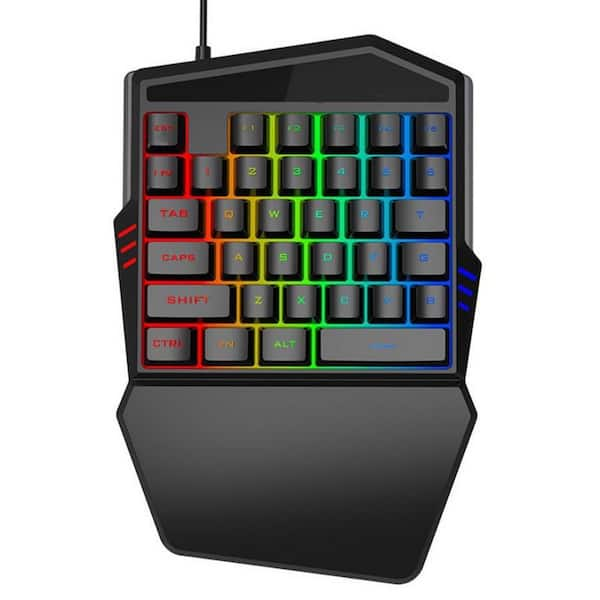The Evolution of the Keystroke: A Deep Dive into Modern Gaming Keyboard Technology
In the expansive universe of PC Gaming, few components are as personal or as critical to performance as the keyboard. It is the primary interface between player and game, the conduit through which strategies are executed, and victories are won. For decades, the conversation was dominated by the simple choice between mushy membrane boards and the satisfying clack of mechanical switches. Today, that landscape has transformed into a high-tech arms race. The modern gaming keyboard is a sophisticated piece of Gaming Hardware, boasting features like adjustable magnetic switches, near-instantaneous polling rates, and software customization that can fundamentally alter gameplay. This article delves deep into the technology powering the next generation of Gaming Keyboards, moving beyond the surface-level debates to explore the innovations that are truly changing the game for casual players and Competitive Gaming professionals alike.
Section 1: Understanding the Core Components of a Gaming Keyboard
Before exploring the cutting-edge advancements, it’s crucial to have a firm grasp of the foundational technologies that define any high-performance keyboard. These core components determine the feel, responsiveness, and longevity of the device, forming the basis upon which modern innovations are built.
Membrane vs. Mechanical: The Foundational Divide
The most fundamental distinction in keyboard construction is between membrane and mechanical designs. A membrane keyboard uses a single rubber dome sheet under the keycaps. Pressing a key pushes the dome down to complete a circuit on a printed circuit board (PCB). This design is inexpensive to produce but often feels “mushy,” lacks precise feedback, and has a shorter lifespan. In contrast, a mechanical keyboard features an individual mechanical switch under each key. These switches contain a housing, a spring, and a stem, providing a distinct, consistent, and more reliable typing experience. For any serious pursuit in PC Gaming, from FPS Games to Strategy Games, a mechanical keyboard is considered the baseline standard due to its superior durability, tactile feedback, and performance.
The Mechanical Switch Trinity: Linear, Tactile, and Clicky
Within the mechanical world, switches are primarily categorized by their feel. Understanding this “trinity” is key to matching a keyboard to your playstyle.
- Linear Switches (e.g., Cherry MX Red): These offer a smooth, consistent keystroke from top to bottom with no tactile bump or audible click. Their uninterrupted travel makes them ideal for fast-paced FPS Games like Valorant or Call of Duty, where rapid, repeated key presses for actions like strafing are common.
- Tactile Switches (e.g., Cherry MX Brown): These provide a noticeable “bump” midway through the keypress, confirming actuation without a loud click. This feedback is excellent for RPG Games and MOBA Games like League of Legends, where precision in ability activation is crucial, and you want to avoid accidental presses.
- Clicky Switches (e.g., Cherry MX Blue): These switches offer both a tactile bump and a distinct, loud “click” sound at the point of actuation. While immensely satisfying for typing, the noise can be distracting for gaming and can be picked up by microphones during Game Streaming on platforms like Twitch.
Build Quality and Form Factor: The Unsung Heroes
Beyond the switches, the physical construction is paramount. Keycaps made from PBT (polybutylene terephthalate) plastic are more durable and resistant to the shine that develops on cheaper ABS (acrylonitrile butadiene styrene) caps over time. The keyboard’s frame, whether plastic or a more rigid aluminum alloy, affects its stability and acoustics. Furthermore, form factor plays a huge role in ergonomics and desk space. While a full-size board offers a numpad, many gamers in the Esports News headlines prefer Tenkeyless (TKL) or 65% layouts, which remove the numpad to provide more room for wide, sweeping mouse movements—a critical factor in games featured in Counter-Strike News and Apex Legends News.
Section 2: The Cutting Edge: Innovations Redefining Keyboard Performance
The latest advancements in Gaming Tech are pushing the boundaries of what a keyboard can do. These innovations focus on minimizing latency, maximizing customization, and providing a level of control previously thought impossible, directly impacting the high-stakes world of Competitive Gaming.

The Magnetic Revolution: Hall Effect Switches Explained
The most significant leap forward in recent years is the widespread adoption of magnetic switches, often referred to as Hall Effect switches. Unlike traditional mechanical switches that rely on two metal contacts touching to register a keystroke, magnetic switches operate without physical contact. A magnet is placed in the switch’s stem, and a sensor on the keyboard’s PCB measures the proximity of this magnet as the key is pressed. This has several game-changing benefits:
- Adjustable Actuation: Because the sensor can detect the precise position of the key at all times, users can customize the actuation point—the depth at which a key press is registered. You can set a hair-trigger 0.1mm actuation for WASD keys for instant movement or a deep 4.0mm actuation for an ultimate ability to prevent misclicks.
- Analog Input: This constant position tracking allows for true analog input, similar to a Game Controller‘s joystick. In a racing or flight simulator game, a gentle press could lead to a slight turn, while a full press results in a sharp one, offering a new dimension of control.
- Enhanced Durability: With no metal contacts to wear down or corrode, magnetic switches boast extreme lifespans, often rated for 100 million or even 150 million keystrokes, far surpassing their traditional mechanical counterparts.
Rapid Trigger: The Secret Weapon for FPS Dominance
A direct and powerful benefit of magnetic switches is a feature known as “Rapid Trigger.” In a traditional keyboard, a key must travel back up past a fixed reset point before it can be pressed again. With Rapid Trigger, the key resets the instant it begins to travel upwards, even by a fraction of a millimeter. This allows for incredibly fast repeated presses. In FPS Games like Valorant, this is a monumental advantage for “counter-strafing,” a technique where a player taps the opposite direction key to stop their momentum instantly, ensuring perfect first-shot accuracy. This feature alone is a compelling reason for many professional players to switch to magnetic keyboards.
The Race to Zero Latency: Decoding Polling Rates
Polling rate refers to how often the keyboard reports its status to the PC, measured in Hertz (Hz). For years, 1000Hz (1ms response time) was the gold standard. However, the latest Gaming Peripherals now boast 4000Hz or even 8000Hz polling rates, theoretically reducing latency to 0.25ms and 0.125ms, respectively. While the perceptible difference for a human is debatable, in a game of milliseconds, every fraction counts. For a professional player competing in an environment where their high-refresh-rate Gaming Monitors are displaying new frames every few milliseconds, ensuring the keyboard’s input is as fresh as possible can provide a tangible, albeit tiny, competitive edge.
Section 3: Software and Customization: Tailoring Your Digital Arsenal
Modern Gaming Hardware is as much about the software as it is about the physical components. Sophisticated software suites and onboard memory allow gamers to transform their keyboard from a simple input device into a highly personalized command center, optimized for specific games and workflows.
Onboard Memory vs. Cloud Profiles
A key consideration is how a keyboard stores its custom settings. Keyboards with onboard memory can save profiles for lighting, macros, and key bindings directly to the device. This is a massive advantage for tournament players or anyone who uses their keyboard on multiple Gaming PCs, as their settings travel with them without needing to install software. Conversely, software-based profiles (often stored in the cloud) can be more complex and numerous, but they require the manufacturer’s software to be running in the background, which can consume system resources.
Practical Application: Advanced Macros and Key Remapping
The ability to remap keys and create complex macros is a cornerstone of keyboard customization. Here are some real-world scenarios:

- MMORPG Player (World of Warcraft, Final Fantasy XIV): A player can record a complex sequence of abilities, including cooldowns, into a single macro key. This simplifies their rotation, allowing them to focus on raid mechanics and positioning. This is a frequent topic in MMORPG News and community forums.
- Strategy Game Player (StarCraft II): In the world of RTS games, actions-per-minute (APM) is king. A player can bind complex build orders or unit groupings to single keys, dramatically increasing their efficiency.
- Game Development: For those following Unity News or Unreal Engine News, developers can create macros for frequently used code snippets or commands, streamlining their development process.
Zone-Based Customization: The Next Frontier
A groundbreaking feature emerging from magnetic switch technology is dynamic, zone-based actuation. This allows a user to assign different performance characteristics to different groups of keys. For instance, in a Battle Royale game like Fortnite or Apex Legends:
- Movement Zone (WASD): Set to a 0.2mm actuation with Rapid Trigger enabled for the most responsive movement and strafing possible.
- Action Zone (E, F, R): Set to a moderate 1.5mm actuation to ensure deliberate actions like reloading or interacting with objects without accidental presses.
- Utility/Ultimate Zone (Q, Z, X): Set to a deep 3.0mm actuation to make it nearly impossible to accidentally trigger a crucial, long-cooldown ability in the heat of a firefight.
This context-aware customization represents a significant evolution, allowing a single keyboard to be perfectly optimized for every aspect of a game simultaneously.
Section 4: Recommendations and Best Practices for Choosing Your Keyboard
Navigating the market for Gaming Keyboards can be daunting. With a clear understanding of the technology, you can make an informed decision based on your specific needs, favorite games, and budget. Here are some tailored recommendations and common pitfalls to avoid.
For the Esports Professional (Valorant, Counter-Strike)
Focus: Speed, precision, and minimal latency. Recommendations: A keyboard with magnetic switches is a top priority for access to Rapid Trigger and adjustable actuation. A smaller form factor (TKL or 65%) is essential for maximizing mouse space. A high polling rate (4000Hz+) can provide a marginal but potentially valuable edge. Linear-style switches are preferred for their smooth travel.

For the Versatile Enthusiast (RPG Games, MOBA Games, Indie Games)
Focus: Balance, functionality, and feel. Recommendations: A tactile switch often provides the most satisfying experience across a wide variety of genres, offering clear feedback without being overly loud. A 75% or TKL layout strikes a great balance between functionality and desk space. Features like a dedicated volume wheel, PBT keycaps, and robust software for macros are highly valuable.
For the Streamer and Content Creator
Focus: Acoustics, aesthetics, and customization. Recommendations: Look for keyboards with sound-dampening foam or gaskets for a quieter, more pleasant sound profile that won’t be picked up by a microphone. Tactile or quiet linear switches are ideal. A full-size layout with dedicated media keys and macro buttons can streamline the streaming workflow. High-quality, customizable RGB lighting is also a key factor for on-camera appeal, a staple of the Twitch News and streaming community.
Common Pitfalls to Avoid
- Marketing Hype: Don’t assume a higher number is always better. An 8000Hz polling rate will not magically make you a better player if your fundamental skills are lacking. Focus on features that provide a tangible benefit to your playstyle, like Rapid Trigger.
- Ignoring Ergonomics: The most technologically advanced keyboard is useless if it’s uncomfortable to use. Consider wrist rests, keyboard height, and keycap profile.
- Forgetting the Sound: Listen to sound tests online before buying. The acoustic profile of a keyboard is a major part of the user experience and is a huge topic within the Gaming Community.
Conclusion: The Keyboard as a Personalized Performance Tool
The journey of the gaming keyboard has been remarkable, evolving from a simple input device to a highly sophisticated and deeply personal piece of performance gear. The advent of magnetic switches, with their adjustable actuation and game-changing Rapid Trigger functionality, marks a pivotal moment in this evolution, offering a level of control and responsiveness previously unattainable. When combined with ultra-high polling rates and intelligent, zone-based software customization, the modern keyboard becomes less of a peripheral and more of an extension of the player’s intent. As you consider your next upgrade, look beyond the RGB lights and brand names. Focus on the underlying technology—the switches, the software, the build quality—and choose a tool that is not just built for gaming, but is built specifically for your game. In the ever-competitive landscape of PC Gaming, the right keyboard is no longer just an advantage; it’s a necessity.












